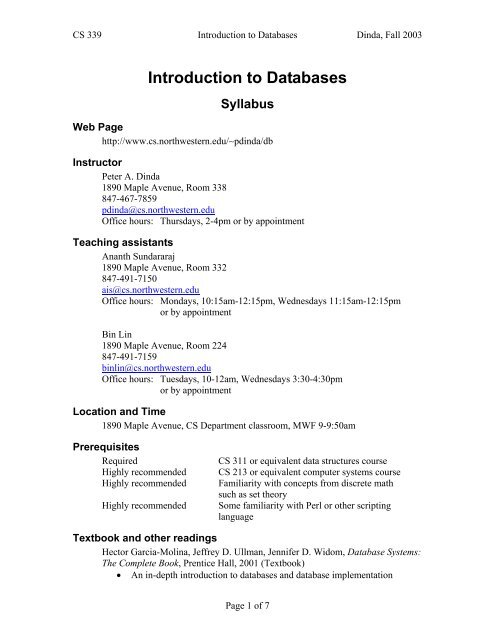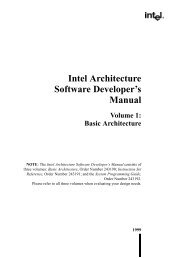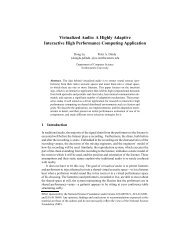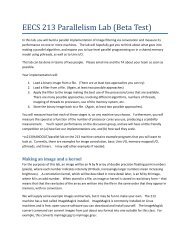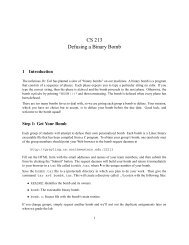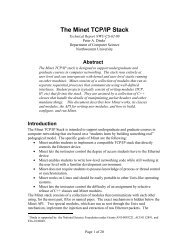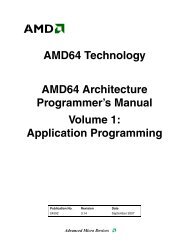Introduction to Databases
Introduction to Databases
Introduction to Databases
Create successful ePaper yourself
Turn your PDF publications into a flip-book with our unique Google optimized e-Paper software.
CS 339 <strong>Introduction</strong> <strong>to</strong> <strong>Databases</strong> Dinda, Fall 2003<strong>Introduction</strong> <strong>to</strong> <strong>Databases</strong>SyllabusWeb Pagehttp://www.cs.northwestern.edu/~pdinda/dbInstruc<strong>to</strong>rPeter A. Dinda1890 Maple Avenue, Room 338847-467-7859pdinda@cs.northwestern.eduOffice hours: Thursdays, 2-4pm or by appointmentTeaching assistantsAnanth Sundararaj1890 Maple Avenue, Room 332847-491-7150ais@cs.northwestern.eduOffice hours: Mondays, 10:15am-12:15pm, Wednesdays 11:15am-12:15pmor by appointmentBin Lin1890 Maple Avenue, Room 224847-491-7159binlin@cs.northwestern.eduOffice hours: Tuesdays, 10-12am, Wednesdays 3:30-4:30pmor by appointmentLocation and Time1890 Maple Avenue, CS Department classroom, MWF 9-9:50amPrerequisitesRequiredHighly recommendedHighly recommendedHighly recommendedCS 311 or equivalent data structures courseCS 213 or equivalent computer systems courseFamiliarity with concepts from discrete mathsuch as set theorySome familiarity with Perl or other scriptinglanguageTextbook and other readingsHec<strong>to</strong>r Garcia-Molina, Jeffrey D. Ullman, Jennifer D. Widom, Database Systems:The Complete Book, Prentice Hall, 2001 (Textbook)• An in-depth introduction <strong>to</strong> databases and database implementationPage 1 of 7
CS 339 <strong>Introduction</strong> <strong>to</strong> <strong>Databases</strong> Dinda, Fall 2003Phillip Greenspun, SQL for Web Nerds, http://philip.greenspun.com/sql/.(Required)• A great introduction <strong>to</strong> RDBMS systems from the perspective of a webapplication developer.Joe Celko, SQL for Smarties: Advanced SQL Programming, 2 nd edition, MorganKaufman, 1999. (Useful)• A collection of wisdom on how working developers get useful things donein SQL.Jim Gray, Andreas Reuter, Transaction Processing: Concepts and Techniques,Morgan Kaufman, 1993. (Related)• Definitive book on transactions, a very important component of anymodern database system.Larry Wall, Tom Christiansen, Jon Orwant, Programming Perl, 3 rd Edition,O’Reilly and Associates, 2000. (Useful)• A detailed introduction <strong>to</strong> the Perl language. Your web-oriented projectsin this class will be based on Perl CGI. You will need <strong>to</strong> know (or learn)only limited amounts of Perl.Objectives, framework, philosophy, and caveatsThis course introduces the underlying concepts behind data modeling anddatabase systems using relational database management systems (RDBMS), thestructured query language (SQL), and web applications (Perl DBI in CGI) asexamples.You will learn:• How <strong>to</strong> model your data using the entity-relationship model• How <strong>to</strong> design a normalized schema in the relational data model• How <strong>to</strong> implement your schema using SQL• How <strong>to</strong> keep your data consistent and safe with your schema using theACID properties that a modern RDBMS gives you• How <strong>to</strong> query your data using SQL• How <strong>to</strong> interface <strong>to</strong> a modern RDBMS from a modern programminglanguage.• How such interfaces are used <strong>to</strong> create web applications• How an RDBMS provides quick access <strong>to</strong> your data using indices, andhow indices are implemented.• How an RDBMS manages the s<strong>to</strong>rage hierarchy.• How an RDBMS optimizes and execute your queries using the relationalalgebra, the theoretical underpinning of database systems.Page 2 of 7
CS 339 <strong>Introduction</strong> <strong>to</strong> <strong>Databases</strong> Dinda, Fall 2003• The his<strong>to</strong>ry of database systems, including old ideas, like hierarchicaldatabases, that are seeing a resurgence of interest <strong>to</strong>day in the context ofXML and LDAP.The textbook I have chosen is actually a combination of two books, anintroduction <strong>to</strong> the concepts and use of databases and an introduction <strong>to</strong> theimplementation of RDBMS systems. We will cover mostly the former.However, this is a very useful and essentially timeless book <strong>to</strong> have on yourbookshelf for both elements.This is a learn-by-doing kind of class. You will get your hands dirty by creating adatabase-based web application that you will propose, design, and implementyourself. The majority of the programming in this class will be from scratch.Be warned that this is the first iteration of this course and I am not a databaseresearcher. Also, I may adjust the pacing of the class as we go based on feedback.ProjectAt the beginning of the course, I will provide you with a simple web application,a tiny web log (“blog”). Microblog is based on an Oracle database and provides aweb interface using a CGI application written in Perl that talks <strong>to</strong> the database viaDBI. This is a very common web application model and one that I encourageyou <strong>to</strong> use for the rest of the class. You will spend three weeks learning howMicroblog works and extending it in several simple ways. The goal is <strong>to</strong>immediately introduce you <strong>to</strong> all the programming elements of the course.For the remainder of the class, you will work on a self-defined project. You willpropose your own problem and spend the remainder of the quarter designing andimplementing your solution.Detailed descriptions of the requirements of both projects are available on thecourse web site. Please be sure <strong>to</strong> read them now so that you know what you’regetting yourself in<strong>to</strong>.HomeworkThere will be three <strong>to</strong> four homework problems sets that will be periodicallyassigned <strong>to</strong> help you improve your understanding of the material.ExamsThere will be a midterm exam and a final exam. The final exam will not becumulative.Grading10 % Dry-run project40 % Self-defined project20 % MidtermPage 3 of 7
CS 339 <strong>Introduction</strong> <strong>to</strong> <strong>Databases</strong> Dinda, Fall 2003Apache, CGI, Perl, DBI,RDBMS, SQL in a nutshell4 10/1 SQL in a nutshell,Walk through Microblog(SQL)HO, Oracle HOPG 1-7, PerlHO, Oracle HO5 10/3 Perl in a nutshell PG 1-7, PerlHO, Oracle HO6 10/6 Walk through Microblog (Perl) PG 1-7, PerlHO, Oracle HO7 10/8 Walk through Microblog (Perl) PG 1-7, PerlHO, Oracle HO8 10/10 Data models and Datamodeling: Why? Goals; andstart Entity-Relationship:Entity sets, attributes,relationships, ER diagrams,instances, multiplicity, roles,multiway9 10/13 Entity-Relationship Model:conversion <strong>to</strong> binaryrelationships, subclassing,design principles10 10/15 Entity-Relationship Model:constraints, weak entity sets11 10/17 Relational Data Model: basics,translating from ER <strong>to</strong>relational12 10/20 Relational Data Model:subclasses, functionaldependencies13 10/22 Relational Data Model:Schema design and normalforms14 10/24 Relational Data Model:Multivalued dependencies15 10/27 Other data models: OO andODL16 10/29 Other data models: ObjectrelationalMidterm Exam, Thursday, 10/30, 6-8:30pm, CS ClassroomCovers Everything Through Lecture 15.GUW 2GUW 2GUW 2GUW 3GUW 3GUW 3GUW 3GUW 4GUW 4, 9.4,9.5Note: youmight findPG 10 usefulreadingHW 1 (ERModeling)outProject A(Microblog)in. Project B(Selfdefined)outHW 1 in,HW 2 outProject Bproposal dueHW 2 duePage 5 of 7
CS 339 <strong>Introduction</strong> <strong>to</strong> <strong>Databases</strong> Dinda, Fall 200317 10/31 Other data models: XML GUW 4 Project Bspecificationdue18 11/3 Relational Algebra: Sets: GUW 5 HW 3 outunion, intersection, difference,selection, projection, Cartesianproduct, joins19 11/5 Relational Algebra: Bags,equivalent expressions, someextended opera<strong>to</strong>rsGUW 520 11/7 Relational Algebra: grouping,constraints, data-mining21 11/10 SQL: strings, regularexpressions, date/time, nulls,3-valued logic, explain plan,subqueries in/exists/>all/>any,correlation22 11/12 SQL: insert/update/delete,multi-statement transactionsusing PL/SQL; create schemas:bit-fields, decimal, blob; drop,alter; indexes; views23 11/14 SQL: Constraints, Triggers,systems aspects.24 11/17 Implementation: S<strong>to</strong>rageInstruc<strong>to</strong>r out of Town25 11/19 Implementation: RepresentingData Instruc<strong>to</strong>r out of Town26 11/21 Implementation: Indexes,BtreesGUW 5GUW 6GUW 6GUW 7, 8.1,8.2, 8.3, 8.4, 8.6GUW 11GUW 12GUW 13, 14.4Project B ERdiagram dueProject BRelationalSchema,DDL, DML,data due,HW 3 due,HW 4 outProject Bapplicationlogic due27 11/24 Implementation: Indexes, GUW 13, 14.4HashesThanksgiving Break28 12/1 Implementation: Indexes, GUW 13, 14.4Bitmaps29 12/3 Implementation: Transactions GUW 18 HW 4 due30 12/5 Slack day Project BWeb frontendduePage 6 of 7
CS 339 <strong>Introduction</strong> <strong>to</strong> <strong>Databases</strong> Dinda, Fall 2003Final Exam, Wednesday, 12/10, 9am-11amPG = Phillip Greenspun, SQL for Web NerdsGUW = Hec<strong>to</strong>r Garcia-Molina, Jeffrey D. Ullman, Jennifer D. Widom, DatabaseSystems: The Complete BookPage 7 of 7


